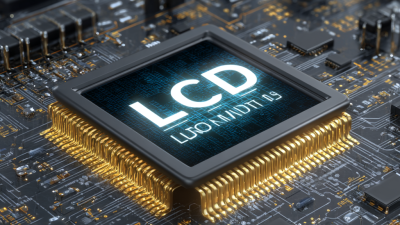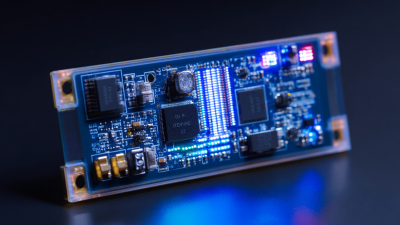Leave Your Message
In today's rapidly evolving technological landscape, the demand for versatile display solutions has reached unprecedented heights. According to a report by MarketsandMarkets, the global LCD display market is projected to grow from USD 103.9 billion in 2020 to USD 144.3 billion by 2025, highlighting the critical role of high-quality display technologies such as Full Function LCD Display. This type of display is essential across a myriad of applications ranging from consumer electronics to professional equipment, offering diverse functionalities including high-resolution imagery, energy efficiency, and adaptability to various environments. As industries continue to prioritize visual communication and user engagement, understanding the multifaceted capabilities of Full Function LCD Display becomes imperative for leveraging its potential in modern technology innovations.

The evolution of LCD technology has drastically transformed the way we interact with devices in our daily lives. From the early monochrome displays of the 1970s to today’s vibrant full-function LCDs, this journey showcases remarkable advancements in color accuracy, resolution, and energy efficiency. The introduction of thin-film transistor (TFT) technology marked a pivotal point, enabling high-quality images and a wider viewing angle. These developments have paved the way for applications beyond traditional screens, expanding into the realms of smartphones, tablets, and smart home devices.
As full-function LCD displays continue to improve, their versatility becomes evident across multiple industries. In healthcare, high-resolution LCDs facilitate precise imaging in medical devices, enhancing diagnostics. In automotive applications, these displays provide critical information in real-time, improving driver experience and safety. Notably, the integration of touch technology has further enhanced their interactivity, making LCDs essential in a world increasingly dominated by digital interfaces. The ongoing innovations in this field suggest that full-function LCD displays will play a crucial role in shaping the future of technology.
The evolution of Full Function LCD displays is significantly influencing modern technology, particularly highlighted at SID 2025, where the latest innovations were showcased. These displays not only provide enhanced visual performance but also integrate key features that are driving industry advancements. Their ability to deliver high-resolution images while supporting multiple applications makes them essential in various sectors, from consumer electronics to automotive displays.
One of the standout innovations presented at the event is the achievement of full-area dewarping in automotive heads-up displays (HUDs). This groundbreaking feature enhances clarity and presents real-time information more effectively, transforming the driver’s experience. The integration of advanced dimming techniques also ensures optimal visibility under diverse lighting conditions, reinforcing the functionality of Full Function LCDs in critical applications. As industries continuously seek improved user experiences and higher performance, the versatility and capabilities of Full Function LCDs will undoubtedly play a pivotal role in shaping the future of display technologies.
| Feature | Description | Impact on Technology | Applications |
|---|---|---|---|
| High Resolution | Displays sharp and clear images with more detail. | Enhances user experience and enables new applications in VR/AR. | Smartphones, Tablets, Virtual/Augmented Reality Headsets |
| Energy Efficiency | Low power consumption leads to longer battery life. | Reduces operational costs and promotes sustainability. | Wearable Devices, IoT Devices, Laptops |
| Thin and Lightweight Design | Compact form factor that saves space and enhances portability. | Facilitates the design of sleek devices. | Wearables, Mobile Devices, Automotive Displays |
| Wide Viewing Angles | Consistent image quality from various angles. | Improves usability in collaborative environments. | Televisions, Monitors, Digital Signage |
| Touchscreen Integration | Enables intuitive and interactive user interfaces. | Enhances user engagement and functionality. | Tablets, Kiosks, Smart Home Devices |
 Full function LCD displays have become integral to various sectors, revolutionizing the way information is conveyed and utilized. In healthcare, these displays enhance patient care through clear, precise patient monitoring systems. Doctors and nurses rely on LCD technology for real-time data visualization, ensuring quick decisions that can significantly impact patient outcomes. The crisp imagery of full function LCDs aids in imaging procedures, making diagnostics more efficient and reliable.
Full function LCD displays have become integral to various sectors, revolutionizing the way information is conveyed and utilized. In healthcare, these displays enhance patient care through clear, precise patient monitoring systems. Doctors and nurses rely on LCD technology for real-time data visualization, ensuring quick decisions that can significantly impact patient outcomes. The crisp imagery of full function LCDs aids in imaging procedures, making diagnostics more efficient and reliable.
In the retail sector, full function LCD displays are not just for advertising; they are essential for interactive customer experiences. Digital signage powered by these displays allows stores to showcase promotions dynamically and provide real-time inventory updates. This enhances customer engagement and streamlines operations, helping businesses respond swiftly to market demands. Additionally, industries like automotive and aerospace leverage full function LCD technology for dashboard displays, making critical information easily accessible while maintaining high safety standards. As technology continues to advance, the versatility of full function LCDs will further shape various sectors, driving innovation and efficiency.
The year 2023 has witnessed a significant rise in the demand for full function LCD technology, reflecting a broader trend of integration and sophistication in modern electronic devices. As industries continue to push for more advanced displays that offer enhanced clarity, adaptability, and interactivity, manufacturers are responding to this need with innovative full function LCD solutions. This surge in demand can be attributed to the increasing prevalence of smart devices, requiring displays that not only convey information but also provide a seamless user experience.
Moreover, the versatility of full function LCDs makes them suitable for a myriad of applications, from consumer electronics to automotive interfaces and industrial equipment. Their ability to support high-definition visuals and touch interfaces has made them a staple in product design across various sectors. As we progress through 2023, businesses are investing heavily in this technology, anticipating that the enhanced user engagement and operational efficiency provided by these displays will give them a competitive edge in a rapidly evolving marketplace.
In recent years, the global TFT LCD panel market has witnessed significant growth, with its value projected to reach $144.42 billion in 2024 and further increase to approximately $220.23 billion by 2033, reflecting a compound annual growth rate of around 4.8%. This growth underscores the enduring popularity and reliability of full-function LCD displays in various applications, including consumer electronics, automotive displays, and industrial solutions. Their versatility, combined with established manufacturing techniques, positions LCD technology firmly in the competitive landscape of display technologies.

In contrast, the emergence of Micro-LED displays presents both advancements and challenges within the sector. A recent study published in a core journal has highlighted the current status of Micro-LED technology and the obstacles it faces in achieving widespread adoption. While Micro-LEDs promise enhanced brightness, improved energy efficiency, and superior color accuracy, the complexity of production and integration remains a significant hurdle. As the industry continues to innovate and compare these technologies, understanding the strengths and weaknesses of full-function LCD displays versus Micro-LED and other alternatives will be crucial for future developments in modern technology.






